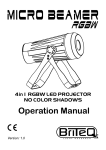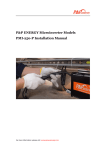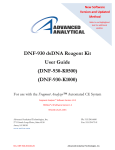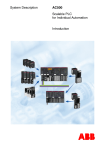Download Troubleshooting Guide
Transcript
Multiplex PCR Troubleshooting Guide Poor amplification of some or all loci Pipetting error / reagents missing Enzyme not activated Annealing step Extension step Primers dNTPs MgCl2 Taq concentration Buffer Template Repeat experiment checking the concentration of all reagents. Make sure that the polymerase and dNTPs are not being depleted before all products can be synthesised. If using a hot start enzyme, check that the full 15 minute activation step is performed before cycling. Annealing temperature – Check that you have the optimal annealing temperature by performing a temperature gradient (2°C increments). Avoid high annealing temperatures for short products. Annealing time - Should be carried out as specified in the protocol. If amplification of all products is weak, try decreasing the annealing time slightly. Extension time – Start with an extension time in minutes equal to the average of the size of the different amplicons (in kb). Increasing the extension time leads to preferential amplification of longer products, while decreasing the extension time results in preferential amplification of shorter products. Extension temperature – When amplifying short products (under 500bp), try lowering the extension temperature (to a minimum of 65°C). Poor primer design – Longer primers (30–35bp) can make multiplex PCR easier. If two loci are very similar, it is useful to design the primers so that at least 1–2 bases at the 3’ end are specific for the locus to be amplifed. Wrong primer concentration – Initially test by combining the desired primer pairs in equimolar quantities and run a PCR. Optimise further by increasing the primer concentrations for any loci that were poorly amplified while simultaneously decreasing the concentrations of the other primers. Primers degraded – Check on polyacrylamide gel. Re-order new primers if necessary. To avoid freeze thawing of dNTP stocks, store as small aliquots instead. Water will evaporate from the stock and condense on the sides of the tubes after thawing, so centrifuge briefly at high speed before use to ensure that components are mixed. Use a final MgCl2 concentration of 1.8–5mM. Increasing the MgCl2 concentration often has a positive effect on the PCR, but if the concentration is too high, the polymerase activity can be inhibited. There is a close relationship between MgCl2 and dNTP concentration. An increase in dNTP concentration should be accompanied by a proportional increase in MgCl2 concentration. Start with a Taq concentration of 1.25Units/50µl and then optimise accordingly. Too much enzyme can result in an unbalanced amplification of various loci, while too little can eliminate certain templates from being amplified at all. KCl-based buffers work better for multiplex PCR. Start with a KCl concentration of 50mM. When working with short templates, it may help to raise the buffer concentration to 1.4x–2x (or the KCl concentration to 70–100mM). When working with very long templates, it may be beneficial to reduce the concentration. Template concentration – Start with a concentration of 200ng/50µl. Increase the amount of template to up to 250ng if you get low amplification. If working with low amounts of template, try scaling down the reaction volume to keep PCR efficiency high. Impure template – Purify template before use. For templates isolated from difficult sources (such as plant) use a commercial mix containing enhancers/detergents. Degraded – Make fresh dilution from stock. Check storage conditions. Extra bands on gel Poor primer design Non-specific amplification Annealing step Contamination Template Taq concentration Each primer pair should be checked for primer-primer interactions. Perform a ‘BLAST’ search to ensure that primer sequences do not match repetitive sequences or other loci elsewhere in the genome. If two loci are very similar, it is useful to design the primers so that at least 1–2 bases at the 3’ end are specific for the locus to be amplified. If using a standard PCR protocol, try performing hot start PCR instead. Annealing temperature – For multiplex reactions, start with an annealing temperature of 52°C. If non-specific products are seen, try increasing the annealing temperature by 2°C increments. Annealing time – Long annealing times may increase the likelihood of nonspecific products. Try decreasing the annealing time. Template contaminated - Purify template before use. DNA polymerase contaminated – All recombinant DNA polymerases will contain small amounts of E.coli DNA. Thermoprime Plus and Thermo-Start® contain minimal amounts compared to competitor enzymes. However, if contamination remains a problem, a ‘BLAST’ search can be performed to check for homology to the E.coli genome. Reagents contaminated – Check to see if there is amplification in the negative (no template) control. If so, repeat with fresh reagents and always use filter tips. Appropriate concentrations of template are in the range of 1–250ng per 50µl reaction, depending on template type. Amplicons from smaller genomes require lower concentrations (e.g. less plasmid DNA is required than human genomic DNA). If non-specific products are seen, it may help to decrease the amount of template. Appropriate concentrations of Taq are in the range of 1–2Units per 50µl reaction. If non-specific products are seen, try decreasing the amount of Taq.











